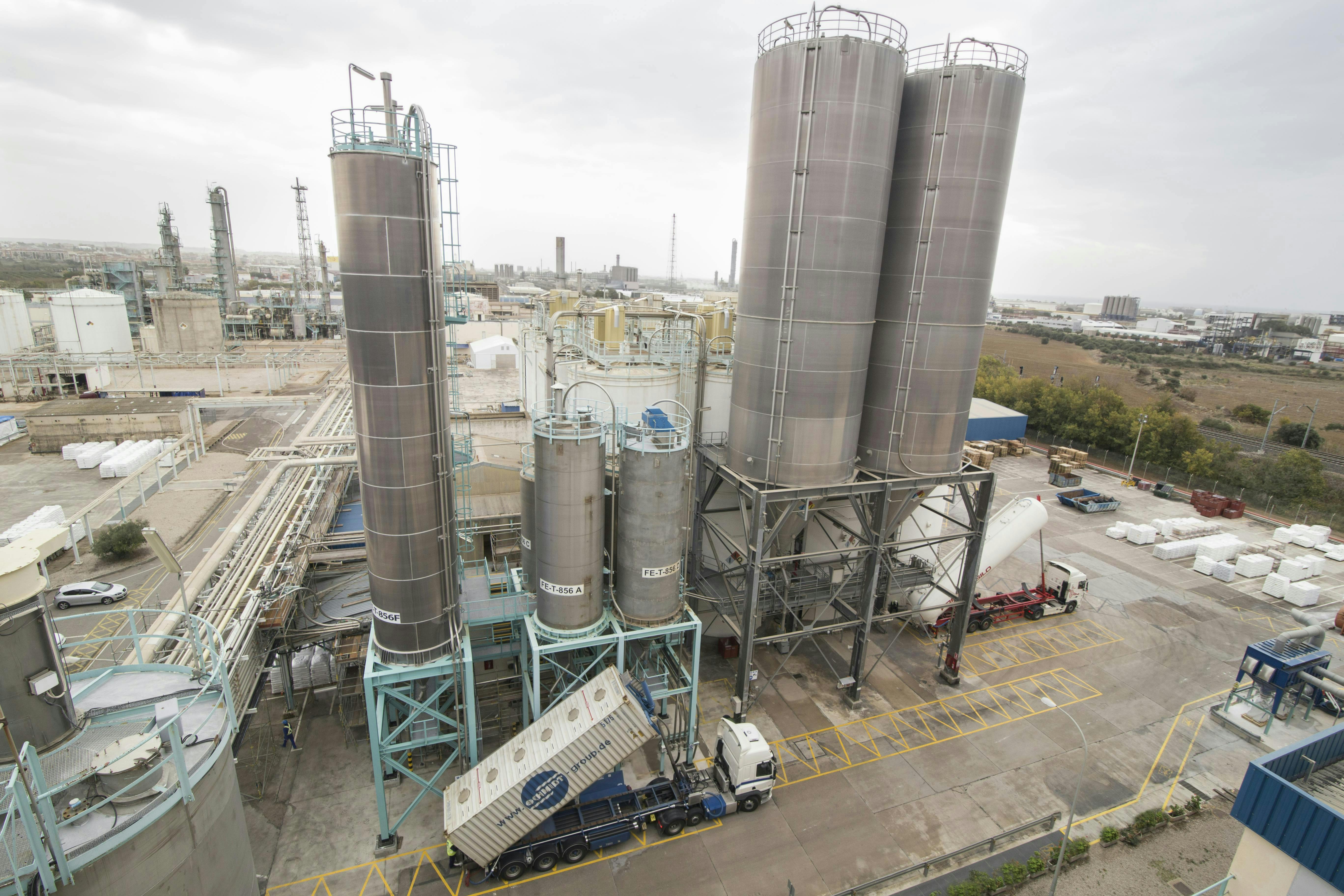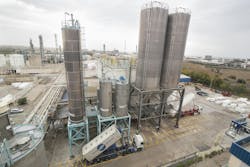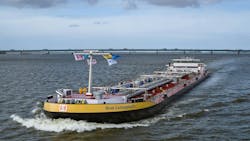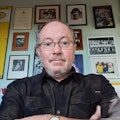Key Takeaways
- Water scarcity threatens $77 billion in economic activity, and global demand is projected to rise 30% by 2050.
- Major chemical companies are testing advanced water treatment technologies through projects like AquaSPICE to enhance recycling in water-stressed facilities.
- Industry partnerships in regions like Tarragona (18% water reuse, targeting 40% by 2028) and BASF's drought adaptations demonstrate effective water management strategies already being implemented.
Water was a major risk for the world’s industrial supply chains even before recent global wildfires, hurricanes, typhoons, floods and droughts made their impact.
The latest figures from the Carbon Disclosure Project (CDP), released in March 2024, suggested at least US$77 billion of economic activity was under threat at just over 600 companies. Ten percent of that was considered at immediate risk.
The organization’s Stewardship at the Source report also found that 50% of large corporate buyers engage their supply chain on water issues.
At the same time, the United Nations expects global water demand to rise by up to 30% by 2050, further straining complex and interwoven supply chains as they struggle to keep up.
The CDP report is based on information provided by companies who are already dealing with the challenges and planning ahead.
For example, in response to the CDP’s water security questionnaire, which was used as a basis for the report, Linde revealed that it drew 453.8 million m3 of fresh water in 2022, including once-through non-contacting cooling water, which is returned to its original source, with its original quality, after usage.
Water is primarily used in cooling and water systems. While the company’s processes can use industrial and brackish water in its processes, Linde’s responses make the point that having access to clean, high quality fresh water reduces the need for water treatment — which saves energy and reduces waste.
However, Linde’s analysis of future water stress on its operations — using the WRI Aqueduct tool — showed in a pessimistic scenario that by 2040, 20% more of the company’s sites could see their baseline water stress increase to high or extremely high, especially for plants on the coast of China.
Testing Treatment Technologies
Companies including Dow, BASF, Solvay and Turkish refiner Tüpraş have just completed 51 months investigating water treatment technologies that Linde and all other operating companies will likely come to rely on.
Finishing up at the end of February 2025, the EU’s €11 million ($11.4 million) Advancing Sustainability of Process Industries through Digital and Circular Water Use Innovations (AquaSPICE) project investigated circular water use technologies suitable for European process industries.
The four companies have all carried out case studies, with most trialing technologies including reverse osmosis (RO), ultrafiltration (UF), ion exchange (IEX), granular activated carbon (GAC), membrane distillation (MD), electrodialysis with reversal possibility (EDR), advanced oxidation processes (AOP), plus coagulation, flocculation and lamella settling.
The skid-mounted pilot processes were housed in two 40-foot shipping containers and could be joined in any sequence desired for testing.
Both Dow’s Böhlen site in Germany and Terneuzen site in the Netherlands participated in the trials.
The Terneuzen site is under severe water stress, as it is located in a coastal area with limited fresh water availability.
Its involvement with the AquaSPICE project investigated ways to reduce freshwater intake intensity by enhancing the internal recycling of various process water streams — including cooling tower blowdown (CTBD) and dilution steam blowdown (DSBD) — and creating a next level of site water management by using smart monitoring, algorithms and control on raw water, discharge and recycle streams.
In the case of CTBD, the objective was to treat it in such a way that it could be directly reused as cooling tower make-up.
To do this, seven water treatment skids were placed on-site and supplied with on-line water from a cooling tower.
The skids could be operated in different configurations and treat two streams at the same time with nominal flow rate of 250 l/hr each.
The CTBD tests considered three trains:
1. GAC → UF → RO → make-up
2. UF → RO → make-up
3. EDR → make-up
According to Dow’s report, the tests proved that very high-quality water can be achieved using GAC-UF-RO configuration. This water is perfectly suitable as a source for boiler feed water production based on the extremely low total organic carbon (TOC) of <50 ppb, however, the conductivity was somewhat high at 100 µS/cm, which would require a second pass RO or polishing using IEX train before sending to mixed bed treatment. The configuration was also very stable in terms of operation for RO and GAC.
The UF needed weekly cleaning, which was attributed to biofouling. This could be controlled in a full-scale installation using a bleach-based chemically enhanced backwash. The overall train recovery was around 70%.
The UF-RO configuration produced water with higher TOC, up to 850 ppb, but lower conductivity of around 50 µS/cm. The RO was not stable, and fast, irreversible fouling occurred, which was again attributed to biofouling.
The quality of the produced water with the EDR skid was 1.8 mS/cm, which is still lower than the CTBD (~3.5 mS/cm) and could be sent back to the cooling tower. However, Dow notes the shortcomings of EDR in terms of recovery and rejection can be improved by employing multiple-pass EDR for improved rejection and multiple stages for improved recovery.
Integrating the RO step would help save 17% of the make-up water, while the EDR could save 8%. If the RO step is implemented, the quality of the cooling tower is expected to remain the same. The recovery of the EDR can be further increased, but chemicals such as antiscalants and acid for pH control need to be dosed, and certain ions such as SO4 and organics can begin to accumulate in the cooling tower, the report said.
In the second phase of the Dow Terneuzen trials, the mobile research infrastructure was deployed to treat DSBD, aiming to reuse it as boiler feed water. A key challenge was removing small, uncharged organics identified in earlier lab tests.
The skids used in this phase also housed membrane-aerated bioreactor and microporous polymer extraction options.
However, no treatment combination successfully reduced TOC to the desired level (<1 ppm). Mini-boiler experiments conducted to assess organic acid formation — a known cause of corrosion in boilers — indicated that the treated water generated more organic acids than Dow's current boiler feed water, deeming it unsuitable for reuse.
According to Dow, the two containers are currently on their way to the company’s water-stressed site at Boehlen, Germany, where the skids will be used in ongoing testing.
More on the results of the case studies can be found at https://aquaspice.eu/.
In an interview to coincide with the end of the project, AquaSPICE coordinator Thomas Wintgens, professor in Urban Water Management at the Institute for Environmental Engineering at RWTH Aachen University, said that the project outputs are very important as guidance for the industry and policymakers. “The results show that treating water in the industrial context to a quality for reuse is possible and that there are different beneficial uses for this recycled water and also that there are also advanced technologies to monitor and to optimize the processes, and I think this can really provide case examples where industry have a need to optimize their water systems,” he added.
Industrial Schemes Already in Hand
Tarragona in Spain is home to the largest chemical hub in southern Europe, with a combined production of over 20 million t/yr. It consists of a north section with a refinery and cracker and a south section that houses petrochemical producers. Both are linked to the nearby port via road and pipeline.
The chemical consortium based there has 33 members, including LyondellBasell (LYB), BASF, Covestro, Dow and Shell, among others.
“The Tarragona area is a typical dry Mediterranean climate. The local river, Francoli, is almost a creek. Drinking water came from wells. In the early 1980s, the consortium reached an agreement with the water agency to bring fresh water from Ebro River, located 80 km away, by pipe,” explained Daniel Tome, LYB HSES manager Tarragona & Barcelona.
Consortium members played a big part in financing the project, in addition to fixing leaks in existing irrigation channels for farms on both sides of the river, so that the water savings would offset the new offtake, resulting in no real freshwater consumption from the river.
However, in the early 2000s, the water agency approached the consortium, asking it to release drinking water from the Ebro for the growing population of Tarragona.
Following consultations with the water and local health authorities, the consortium installed a tertiary treatment system in the urban wastewater treatment plant. The water produced was used for processing and cooling, using filtering, reverse osmosis, ultraviolet and chlorination technologies.
“By 2023, after 11 years of operation, the treatment plant was producing 6 million m3/yr of regenerated water, over 18% of its total demand, and the equivalent of the freshwater consumed by 114,000 people per year,” added Tome.
In 2022, LYB and eight other operating companies at the hub agreed to establish a second common wastewater treatment plant to help them meet new EU emission standards.
Run by industrial water treatment specialist AITASA, the new facility is currently operating at 40,000 m3/day.
Even so, consortium members are considering new modifications to further recycle and reuse treated water (Figure 1).
"Since a lack of fresh water is both a near- and long-term issue, a project is planned for another tertiary treatment system in the common industrial wastewater treatment plant. The goal is to reach 40% regenerated water by the end of 2028,” Tome said.
Meanwhile, BASF has a transportation challenge at its Ludwigshafen headquarters in Germany. Here, the river Rhine is a vital artery, with about 40% of the total incoming and outgoing volume transported by ship. So, navigability during low water is of critical importance.
A drought in 2018 and a more recent one in 2022 saw water levels in Europe’s busiest river drop to critical levels, severely limiting inland shipping.
An analysis of the earlier drought in the German Economic Review in 2023, "Extreme Weather Events and Economic Activity: The Case of Low Water Levels on the Rhine River," found that low water levels led to a 15% drop in industrial production in Germany, cutting GDP by 0.4%.
For BASF, this drought was an incentive to double the number of specialist vessels it exclusively charters for low-water operations. It also ordered several specially constructed vessels, including the Stolt Ludwigshafen (Figure 2), which was inaugurated in May 2023.
“With its high load capacity and extremely shallow draft, this vessel can reliably and safely deliver essential raw materials for the supply of the Ludwigshafen site even in extreme low water situations. All ships, including the Stolt Ludwigshafen, are utilized year-round at BASF according to their operational capabilities,” said a spokeswoman.
The company is also working with the German Federal Institute of Hydrology to further develop a digital early warning system for low water levels in the Rhine. This provides a lead time of up to six weeks, which the spokeswoman noted is “enough to allow for situational adjustments to logistics activities at the Ludwigshafen site.”
Water level forecasts from the Institute are automatically transferred into BASF's early warning system. An algorithm calculates different probability scenarios of low water, helping the company to implement objective and robust risk management.
“This low water early warning system is tailored to specific questions and relevant water levels for BASF and is not used by third parties,” noted the spokeswoman.
In parallel with these efforts, the site continuously analyzes its water management and implements improvement measures and optimized operating methods to further reduce water consumption and use.
One example is using recooling plants to reduce cooling water demand and, therefore, water withdrawal from the Rhine. In a recooling plant, warmed cooling water is trickled and cooled in a stream of air so that it can then be reused multiple times as cooling water.
In fact, the company has expanded the capacity of the existing recooling plants in recent years and is currently building new ones. Since 2018, BASF has added 400 MW of cooling capacity, bringing the current total to 1300 MW.
Not only does this help the company cut its need for cooling water from the Rhine, but also reduces the amount of heat it discharges via water into the river.
The company’s General Lago site in Argentina, where the headquarters of its dispersions and resins division and the distribution center for crop protection products are located, has followed a similar recooling strategy to cut its use of water by 15%.⊕
About the Author
Seán Ottewell
Editor-at-Large
Seán Crevan Ottewell is Chemical Processing's Editor-at-Large. Seán earned his bachelor's of science degree in biochemistry at the University of Warwick and his master's in radiation biochemistry at the University of London. He served as Science Officer with the UK Department of Environment’s Chernobyl Monitoring Unit’s Food Science Radiation Unit, London. His editorial background includes assistant editor, news editor and then editor of The Chemical Engineer, the Institution of Chemical Engineers’ twice monthly technical journal. Prior to joining Chemical Processing in 2012 he was editor of European Chemical Engineer, European Process Engineer, International Power Engineer, and European Laboratory Scientist, with Setform Limited, London.
He is based in East Mayo, Republic of Ireland, where he and his wife Suzi (a maths, biology and chemistry teacher) host guests from all over the world at their holiday cottage in East Mayo.




